In his 2019 Berkshire Hathaway Annual Letter, Warren Buffett discusses the lessons that he learned from Edgar Lawrence Smith’s “Common Stocks as Long Term Investments”, the crucial insight that well-managed companies retain and reinvest a portion of their profits, generating compound interest and increasing long-term value.
This challenged the pre-Smith view of stocks as short-term speculations. Buffett realized the importance of evaluating stocks based on their potential for sustained growth through retained earnings, rather than short-term market movements.
Smith’s work highlighted the power of long-term investment in stocks, emphasizing that reinvested profits significantly contribute to wealth accumulation, a lesson that greatly influenced Buffett’s investment philosophy.
Here’s an excerpt from the letter:
In 1924, Edgar Lawrence Smith, an obscure economist and financial advisor, wrote Common Stocks as Long Term Investments, a slim book that changed the investment world. Indeed, writing the book changed Smith himself, forcing him to reassess his own investment beliefs.
Going in, he planned to argue that stocks would perform better than bonds during inflationary periods and that bonds would deliver superior returns during deflationary times. That seemed sensible enough. But Smith was in for a shock.
His book began, therefore, with a confession: “These studies are the record of a failure — the failure of facts to sustain a preconceived theory.” Luckily for investors, that failure led Smith to think more deeply about how stocks should be evaluated.
For the crux of Smith’s insight, I will quote an early reviewer of his book, none other than John Maynard Keynes: “I have kept until last what is perhaps Mr. Smith’s most important, and is certainly his most novel, point. Well-managed industrial companies do not, as a rule, distribute to the shareholders the whole of their earned profits. In good years, if not in all years, they retain a part of their profits and put them back into the business. Thus there is an element of compound interest (Keynes’ italics) operating in favour of a sound industrial investment. Over a period of years, the real value of the property of a sound industrial is increasing at compound interest, quite apart from the dividends paid out to the shareholders.”
And with that sprinkling of holy water, Smith was no longer obscure.
It’s difficult to understand why retained earnings were unappreciated by investors before Smith’s book was published. After all, it was no secret that mind-boggling wealth had earlier been amassed by such titans as Carnegie, Rockefeller and Ford, all of whom had retained a huge portion of their business earnings to fund growth and produce ever-greater profits. Throughout America, also, there had long been small-time capitalists who became rich following the same playbook.
Nevertheless, when business ownership was sliced into small pieces — “stocks” — buyers in the pre-Smith years usually thought of their shares as a short-term gamble on market movements. Even at their best, stocks were considered speculations. Gentlemen preferred bonds.
Though investors were slow to wise up, the math of retaining and reinvesting earnings is now well understood. Today, school children learn what Keynes termed “novel”: combining savings with compound interest works wonders.
You can find the entire letter here:
For all the latest news and podcasts, join our free newsletter here.
Don’t forget to check out our FREE Large Cap 1000 – Stock Screener, here at The Acquirer’s Multiple:



